Ana Espinosa, The Estée Lauder Companies’ Packaging Sustainability team04.15.24
Have you ever wondered about the complex world of sustainability challenges and innovations behind the allure of beauty packaging? In the luxury cosmetics industry, the creation of unique and attractive packaging involves a blend of materials, decorations, sizes, and formats. However, these attributes pose challenges for designing cosmetics packaging, whether luxurious or not, with recyclability and sustainability in mind.
In the beauty industry, “small-size” packaging plays an important role in helping the industry respond to various consumer and business needs and gives brands the ability to provide travel sizes, enable trial of products, and protect makeup products like mascara and lipstick. Despite their importance, current recycling infrastructure in the U.S. struggles to sort and collect small-size packages, posing a challenging, but exciting opportunity for the industry to tackle.
In the beauty industry, “small-size” packaging plays an important role in helping the industry respond to various consumer and business needs and gives brands the ability to provide travel sizes, enable trial of products, and protect makeup products like mascara and lipstick. Despite their importance, current recycling infrastructure in the U.S. struggles to sort and collect small-size packages, posing a challenging, but exciting opportunity for the industry to tackle.
Designing Recyclability and Sustainability Into Small-Sized Packaging
While some may suggest solving recyclability concerns by increasing package size, the use of more material can bring unintended consequences, such as potentially higher carbon footprints and more waste. So, how can we design recyclability and sustainability into small-sized packaging?- Seek out collaborations: Partnerships with packaging suppliers, recyclers, and organizations like The Sustainability Consortium can help understand the challenges of changing the current recycling infrastructure and how to design systems and packages that are better suited for them.
- Design with recyclable-ready principles: Consider switching materials to create mono-material packages or choosing materials more valuable for the recycling industry.
- Use sustainability tools: Implement lifecycle assessments as design tools to understand the greenhouse gas impact of different options for small-size packaging. Despite the complexities, this information can help guide decisions that align with your company's sustainability strategy.
- Enable takeback programs and consumer education: Encourage product return initiatives and educate consumers about the importance of recycling, contributing to a more responsible lifecycle for beauty packaging.













